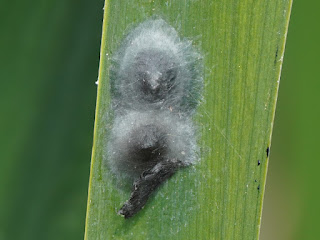A Common Pochard at the Serpentine island has five ducklings. This is the first time I've known one of these ducks to breed in the park, though a few years ago a Red-Crested Pochard managed to raise two ducklings on the Long Water.
The female Mute Swan at the island hauled up algae for her four cygnets ...
... and with the family of six their father, on the right here, was helping with the feeding. He is a model father and, from the swan point of view, his murderous aggressiveness towards rivals is a virtue.
The Egyptian Goose at the Triangle with five goslings called them into the water when she saw a dog approaching. The dog was on a lead, but better safe than sorry.
The Coots nesting in the fountain pool in the Italian Garden have hatched seven chicks and were busy feeding them.
The Coot nest at the bridge with two females who laid eggs at different times had one more chick this morning, bringing the total up to five. The oldest two are two week old and far larger than their siblings.
Duncan Campbell passed by this evening and saw two more eggs beginning to hatch, so now there are seven. Here is his picture.
The nest in deep water at the Serpentine outflow has at least five eggs in it.
The Great Crested Grebes at the island are making another vague attempt at rebuilding their nest against the wire basket.
Several Lesser Black-Backed Gulls were going over the newly raked flower beds in the Rose Garden, hoping to find exposed worms. The ground is very dry and they are finding it hard to get up worms in the ordinary way.
A Wren nesting near Mount Gate scolded a Carrion Crow in the top of the tree. It managed to make an amazingly loud noise despite having a couple of caterpillars in its beak.
An unusually visible Wood Pigeon nest in the rose pergola in the Rose Garden has one young bird and an adult in it. The nest looks far too small for them and I thought they had reused a Blackbird nest, but apparently Wood Pigeons don't bother to build anything larger.
A Peregrine, I think the male of the pair, was none too visible on the barracks tower. But he started preening and turned half round for a moment, so I got a hasty picture.
The male Little Owl at the Round Pond was having trouble with five Magpies, and flew in and out of the hole in the dead tree where his mate is nesting. I bought off the Magpies with peanuts and got a picture of the owl in a horse chestnut.
This is a female Magpie in a hawthorn tree soliciting another peanut.
Blue-Tailed Damselflies perched on a rail in the Italian Garden.
There were several of these grey fluffy things on the iris leaves. They seem to be cocoons, and what looks like an empty pupa case is hanging out of one, but I have no idea what insect made them.


%202023%201a.jpg)









I am also puzzled by the grey things. My best guess is and Iris Borer Moth but I am not sure at all since I do not know what they (or their cocoons) look like. Interesting news with the Damselflies. I normally have quite a bit of difficulty photographing them through the reeds.
ReplyDeleteI was near the Speke Monument this morning and found an large flock of Chaffinches, Goldfinches(finally!) and Greenfinches. There were also a few Chiffchaffs, Stock Doves and Robins.
Theodore
I can't find a picture of an iris borer cocoon either, but I think they pupate in the rhizomes and not on the leaves. The leaves didn't seem to be damaged by whatever it was.
DeleteI also found a fine selection of finches singing near the Speke obelisk as well as other songbirds. The area between the obelisk and the leaf yard is not much visited by humans, which helps.
An excellent tradeoff, everyone wins: the magpie gets the peanut, the owl gets to be left alone, and we get an owl picture. If we were to look up the definition of win-win there's be under a picture of this.
ReplyDeleteTinúviel
For now, fine. But there is going to be more Magpie trouble, especially since the female owl seems to be nesting and owlets can be expected. It's all part of an owl's life, of course.
DeleteIt's a good thing I wasn't born a god. I'd be sorely tempted to mess with nature, destiny, and the like, taking a short view of things. Probably would cause the universe to spontaneously implode or something.
DeleteTinúviel
If it did, you could always plead the Augustinian theodicy.
DeleteI think there are three pigeons in the nest. In the latter section there's a blob between the obvious birds which clearly moves at 0.22. Jim
ReplyDeleteThank you. Will look again. It looked like two when I was actually there.
DeleteGood news regarding the Pochards. Let's hope they avoid the hungry gulls!
ReplyDeleteThey're already diving, which is helpful for survival. We had some Tufted ducklings that came through a few years ago.
DeleteAny idea about that grey cocoon on the iris leaf?
Sadly not Ralph. Sorry the number of Pochards are down to 3 young.
ReplyDeleteSorry to keep chucking mystery insects at you. My interest in the many species of bee in the Rose Garden vastly exceeds my knowledge.
Delete